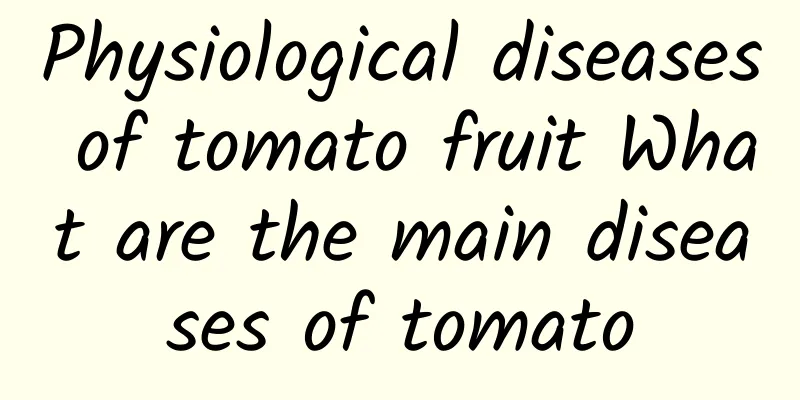Physiological diseases of tomato fruit What are the main diseases of tomato

|
What should we do about physiological diseases of tomato fruits? Today I will tell you how to solve the problem. Green back fruit1. Symptoms: After the fruit turns red, green areas or patches remain on the shoulders or near the fruit stem and it never turns red. The fruit is red and green, the flesh in the green area is harder, the fruit tastes sour, and has a poor taste. 2. Cause of disease: It occurs when nitrogen fertilizer is applied excessively and tomato plants grow too vigorously, especially when there is too much nitrogen fertilizer, too little potassium fertilizer, boron deficiency, and dry soil. The disease is most serious. Physiological diseases of tomato fruits are caused by inappropriate environmental conditions. Once the environmental conditions return to normal, the physiological diseases stop developing and sometimes return to normal. There are many causes of physiological diseases, such as inappropriate temperature, insufficient or excessive light, water imbalance, nutritional imbalance, and improper planting management factors such as pesticide damage and fertilizer damage. 3. Prevention and control methods: During the fruit expansion period, supplement potassium in time and spray compound micro-fertilizer containing potassium and boron. Brown fruit1. Symptoms: The fruit turns red when ripe, but the red is exposed to brown, making the fruit dark brown. The fruit surface is dirty, the glossiness is poor, and the commercial quality is significantly reduced. 2. Causes of the disease: High temperature and weak light are the root causes of the production of brown fruit. When the temperature is lower than 24°C during the fruit ripening period, the chlorophyll will increase and the formation of lycopene will be delayed, leading to the appearance of brown fruit. Undue or excessive application of nitrogen fertilizer, lack of potassium and boron, and excessive fertilization in a greenhouse with crop rotation and soil salt evolution can easily cause brown fruit. 3. Prevention and control methods: Carry out fruit ripening treatment to avoid sudden dryness, sudden wetness, or excessive dryness or wetness. Or excessive nitrogen fertilizer application to avoid excessive vegetative growth! Navel rot fruit1. Symptoms: The disease occurs in the young fruit stage, which is the size of a ping-pong ball to an egg. Initially, the top of the fruit (navel) is dark green or dark gray, which quickly turns into dark black. The flesh loses water and the top becomes flat or concave. The lesions sometimes have concentric rings. The peel and flesh are soft and generally not rotten. The diseased fruit will rot when the air is humid. 2. Cause of disease: The direct cause is calcium deficiency. The reasons for calcium deficiency are: first, water supply is imbalanced. Insufficient water supply under drought conditions, or alternating dry and wet conditions, hinder the absorption of water by the tomato roots, reduce root vitality, and inhibit calcium absorption; second, excessive use of nitrogen and potassium fertilizers inhibits calcium absorption; third, high temperature drying hinders calcium absorption and its movement in the plant; fourth, fruits treated with growth regulators are prone to navel rot. 3. Prevention and control methods: First, avoid excessive application of nitrogen and potassium fertilizers while applying a large amount of quick-acting fertilizers at one time; second, prevent the soil from drying out and increase the amount of irrigation; third, after entering the fruiting period, spray 0.1% to 0.3% calcium chloride aqueous solution once every 7 days, or continuously spray calcium fertilizers such as Green Fenwei No. 3. Sunburn Fruit1. Symptoms: The burned part of the fruit shows large chlorotic white spots, and the surface is shiny and translucent leathery, sunken. In the later stage, the diseased part turns yellow, and sometimes wrinkles appear on the surface, shrinks and hardens, and the flesh becomes necrotic and turns brown. 2. Prevention and control methods: Reasonable density planting; excessive pruning and branch removal; when selecting inflorescences and pruning and tying vines, the inflorescences should be placed on the inner side of the support, and shaded by their own leaves; when topping, two leaves should be left on the top of the last fruit cluster to shade the fruit cluster; timely ventilation and lowering of room temperature; cover with a shade net to avoid strong light. 3. Cause of the disease: The fruit is burned due to high temperature in the part exposed to direct sunlight. |
<<: Soilless cultivation technology of tomatoes
>>: Tomato fertilization precautions
Recommend
The efficacy and nutritional value of smilax
With the continuous improvement of living standar...
What are the effects of ginseng fruit and how to eat ginseng fruit
Ginseng fruit, also known as melon nightshade, is...
Bitter Melon Juice Weight Loss Method
Bitter melon has a certain weight loss method, an...
High-fiber foods What are the ways to eat high-fiber foods
If you pay attention to health preservation, then...
What is the shelf life of eggs?
The nutritional value of eggs is widely recognize...
Candied Dates
Candied dates contain a lot of protein, carbohydra...
The effect of fungus porridge
I wonder how much you know about the effects of bl...
The efficacy and function of early chrysanthemum
Early Chrysanthemum is a plant of the Asteraceae ...
The efficacy and function of walnut seeds and the taboos of walnut seeds
In daily life, we all come into contact with waln...
How is Carlyle Group? Carlyle Group reviews and website information
What is the Carlyle Group? The Carlyle Group (abbr...
How is Deutsche Telekom? Deutsche Telekom reviews and website information
What is the website of Deutsche Telekom? <div 德...
What is Jason Statham like? Jason Statham reviews and website information
What is Jason Statham's website? Jason Statham...
The benefits of eating bergamot
Bergamot is the fruit of the plant Buddha's h...
How is Kuwait Airways? Kuwait Airways Reviews and Website Information
What is Kuwait Airways? Kuwait Airways (KUWAIT AIR...
wine
I believe everyone is familiar with grapes, right...









